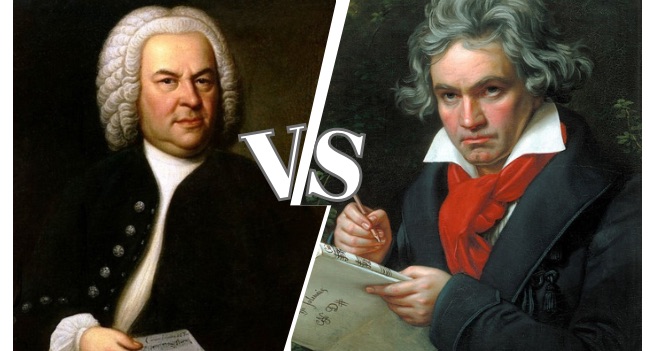

Johann Sebastian Bach and Ludwig van Beethoven were two of the greatest composers in classical Western music. They were both Germans. Beethoven, a contemporary of Mozart, was born 20 years after the death of Bach. They’re two of the “three Bs” of classical music – Bach, Beethoven and Brahms.
Bach lived in the Baroque period while Beethonven was a crucial figure in the transition from the Classical to the Romantic era.
Beethoven was an admirer of Bach. He often played the preludes and fugues of Bach’s Well-Tempered Clavier. Beethoven called Bach the “Urvater der Harmonie” (“Original father of harmony”) and, in a pun on the literal meaning of Bach’s name, “nicht Bach, sondern Meer” (“not a brook, but a sea”).
Both composers struggled with disability; Bach became increasingly blind towards the end of his life while Beethoven began to lose his hearing when we was 26 and became completely deaf in the ensuing decade.
Comparison chart
- Early period – His work during this period was greatly influenced by Haydn and Mozart. Some important pieces were the first and second symphonies, the set of six string quartets Opus 18, the first two piano concertos, and the first dozen or so piano sonatas, including the famous Pathétique sonata, Op. 13.
- Middle period – This period is referred as the Heroic period. It was during this period that he started losing his hearing. This period works include six symphonies (Nos. 3–8), the last three piano concertos, the Triple Concerto and violin concerto, five string quartets (Nos. 7–11), several piano sonatas (including the Moonlight, Waldstein and Appassionata sonatas), the Kreutzer violin sonata and Beethoven’s only opera, Fidelio.
- Late Period – The works of this period are characterized by intellectual depth, their formal innovations, intense and personal expression. The String Quartet, Op. 131 has seven linked movements, and the Ninth Symphony adds choral forces to the orchestra in the last movement. Other compositions from this period include the Missa Solemnis, the last five string quartets (including the massive Große Fuge or Grand Fugue) and the last five piano sonatas.
Musical Style
This section needs expansion.
In memory
Bach is commemorated as a musician in the Calendar of Saints of the Lutheran Church on 28 July. He is honored together with George Frideric Handel and Henry Purcell with a feast day on the liturgical calendar of the Episcopal Church (USA) on 28 July.
A number of movies have been made about Beethoven, including
- Eroica – 1949, an Austrian film
- The Magnificent Rebel –1962, was produced by Walt Disney
- Immortal Beloved – 1994, was written and directed by Bernard Rose.
- Eroica – 2003, a BBC/Opus Arte film
- Copying Beethoven – 2006
For his 75th anniversary The Beethoven Monument was unveiled in Bonn in 1845. A statue of Beethoven was unveiled in Vienna in 1880.


